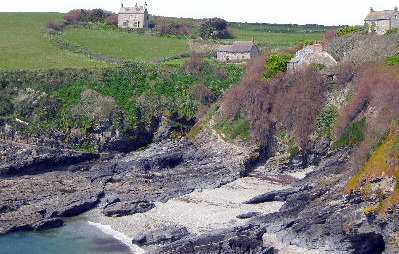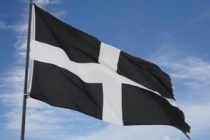John Carter, the 'King of Prussia', freetrader, staunch Methodist

Born 1770 at Breage near Helston, John Carter matured to become one of the biggest rogues on the coast, the self styled King of Prussia.
John Carter, the eldest of the Carter brothers, named the cove Prussia Cove, because of his deep admiration for Frederick the Great, King of Prussia. John Carter himself became known as the King of Prussia, as he engaged in ever more daring encounters with the revenue.
Carter was a mixture of hard working fisherman, honest merchant and out and out rogue. He operated out of Bessies Cove, a rocky inlet near Perranuthnoe in Mount's Bay. It was an area notorious for lawless gangs of wreckers and smugglers. But it was a time when few local people thought smuggling to be a crime. John and his brother Henry were well known along the French coast, but during the French Wars they were arrested and imprisoned in St Malo for a year on one occasion.
The wars that Britain was fighting were costing the country a lot of money. This had to be raised by taxation, particularly on imported goods. Owners of small, fast boats could to evade the high taxes if they could evade customs officials enforcing their collection. High duties had been imposed on luxury items such as wine, spirits and tobacco.
Cornwall was a good smuggling base. It was fairly remote and the coast was suited for running in contraband. The Carter's home, Prussia Cove (originally Portleah), is tucked under a sheltered headland at the centre of Mount's Bay. The little cove had slipways for landing goods, they had a house with cellars and lofts where they could store the contraband that they had landed, and it was difficult to get to by land without being seen by lookouts.
John Carter and Harry were confirmed Methodists. Harry is said to have held Sunday services on the quayside for smugglers when he was exiled in Roscoff. The Carters forbade swearing on their vessels.
The Carter owned two large vessels, and were good seamen with an encyclopedic knowledge of the Cornish and the French coasts. These boats were a 19-gun cutter of 160 tons, and a 20-gun lugger, each with a crew of around 30 men. Each vessel would be equipped with at least one smaller boat for inshore work.
The local Cornish community were into smuggling, most saw nothing immoral in it, and there was therefore a network of people to store, transport and sell the goods in distant markets.
Inevitably battles broke out, as both sides were armed to the teeth. Harry Carter records on such battle in 1788 - "the bone of my nose was cut right in two and two very large cuts in my head that two or three pieces of my skull worked out afterwards". Harry fled and remained in hiding for three months for his wounds to heal.
On one occasion John fired on a revenue cutter from a gun battery on top of the cliffs. The revenue men was attempting to follow one of the Carters' vessels into Prussia Cove. On another John Carter broke into the Customs House at Penzance, John and took back contraband that had been taken from him. "John Carter has been here", reported one of the customs officers. "We know it because he has taken nothing away that was not his own".
In 1803, the Carters' house in Prussia Cove was put up for for sale by auction. A copper mine had been opened on the cliffs overlooking the cove, and coal was landed to drive the mine's steam engine. Perhaps the wealth from mining was more lucrative than smuggling. By 1807 John just disappears from the cove, and Harry retired to a farm nearby, and went on to full time preaching. Other members of the Carter family are said to have continued smuggling into the 1820s. However the Revenue men were getting better at their job, and smuggling became less profitable.
In 1825 the building of a Coastguard Station at Prussia Cove finally put an end to smuggling in Prussia Cove.
Although John Carter's cottage was demolished in 1906, the cove still holds the romance of its notorious connections with wrecking and smuggling.
This article has been kindly provided by Kernow Matters to Us and is part of the series on Famous Folk of Kernow (Cornwall).
- Cornish
- English
- Log in to post comments





